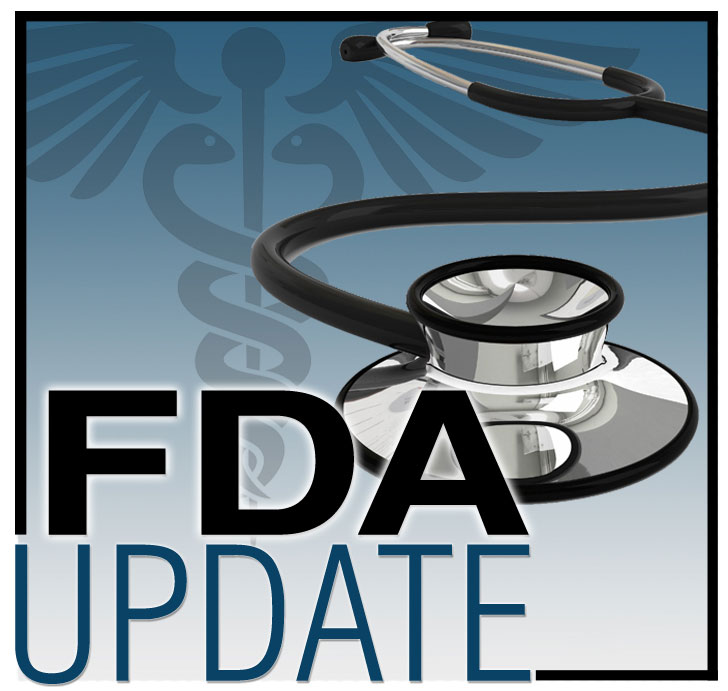FDA Approves Dabrafenib With Trametinib for Pediatric Patients With Low-Grade Glioma and a BRAF V600E Variant
On March 16, 2023, the U.S. Food and Drug Administration (FDA) approved (https://www.fda.gov/drugs/resources-information-approved-drugs/fda-approves-dabrafenib-trametinib-pediatric-patients-low-grade-glioma-braf-v600e-mutation) dabrafenib (Tafinlar®) with trametinib (Mekinist®) for pediatric patients aged one year and older with low-grade glioma (LGG) that have a BRAF V600E variant who require systemic therapy. FDA also approved new oral formulations of both drugs for patients who cannot swallow pills. It is the first FDA approval of a systemic therapy for first-line treatment of pediatric patients with LGG that have a BRAF V600E variant.

Efficacy was evaluated in study CDRB436G2201 (NCT02684058), a multicenter, open-label trial in patients with LGG (World Health Organization grades 1 and 2) requiring first-line systemic therapy. Patients were randomized 2:1 to receive either dabrafenib plus trametinib (D+T) or carboplatin plus vincristine (C+V). Researchers identified BRAF variant status prospectively by local or central laboratory tests and performed retrospective testing of available tumor samples by the central laboratory to evaluate variant status. Patients received age- and weight-based dosing of D+T until they no longer derived benefit or experienced unacceptable toxicity. C+V was dosed based on body surface area at 175 mg/m2 and 1.5 mg/m2 (0.05 mg/kg for patients less than 12 kg), respectively, as a one 10-week induction course, followed by eight 6-week cycles of maintenance therapy.
The major efficacy outcome measure was overall response rate (ORR), as evaluated by independent review based on RANO LGG (2017) criteria. Additional efficacy outcome measures were progression-free survival (PFS) and overall survival (OS). The primary analysis was performed when all patients had completed at least 32 weeks of therapy.
In the LGG cohort, 110 patients were randomized to receive D+T (n = 73) or C+V (n = 37). ORR was 46.6% (95% CI = 34.8, 58.6) in the D+T arm and 10.8% (95% CI = 3.0, 25.4) for those receiving C+V (p = < 0.001). Duration of response was 23.7 months (95% CI = 14.5, not estimable) in the D+T arm and not estimable (95% CI = 6.6, not estimable) in the C+V arm. PFS was 20.1 months (95% CI = 12.8, not estimable) and 7.4 months (95% CI = 3.6, 11.8; HR = 0.31 [95% CI = 0.17, 0.55]; p = < 0.001) in the D+T and C+V arms, respectively. When the interim OS analysis was conducted after all patients had completed at least 32 weeks of treatment or had discontinued earlier, there was one death on the C+V arm. The OS results at the interim analysis did not reach statistical significance.
In the pooled safety population of pediatric patients receiving D+T (n = 166), more than 20% of patients experienced pyrexia (66%), rash (54%), headache (40%), vomiting (38%), musculoskeletal pain (36%), fatigue (31%), dry skin (31%), diarrhea (30%), nausea (26%), epistaxis and other bleeding events (25%), abdominal pain (24%), and acneiform rash (23%). More than 2% of patients receiving D+T experienced grade 3 or 4 laboratory abnormalities, such as decreased neutrophil count (20%) and increased alanine (3.1%) and aspartate aminotransferase (3.1%).
The recommended doses for dabrafenib and trametinib in pediatric patients are based on body weight. Dabrafenib is administered orally twice daily, and trametinib is administered orally once daily. The combination therapy is administered until patients experience disease progression or unacceptable toxicity.
View full prescribing information for dabrafenib (https://www.accessdata.fda.gov/drugsatfda_docs/label/2023/202806s025lbl.pdf) and trametinib (https://www.accessdata.fda.gov/drugsatfda_docs/label/2023/204114s025lbl.pdf).
The review and approval used the Assessment Aid (https://www.fda.gov/about-fda/oncology-center-excellence/assessment-aid), a voluntary submission from the applicant to facilitate the FDA’s assessment.
The application was granted priority review, breakthrough designation and orphan drug designation. FDA expedited programs are described in the Guidance for Industry: Expedited Programs for Serious Conditions—Drugs and Biologics (https://www.fda.gov/regulatory-information/search-fda-guidance-documents/expedited-programs-serious-conditions-drugs-and-biologics).
Healthcare professionals should report all serious adverse events suspected to be associated with the use of any medicine and device to FDA’s MedWatch Reporting System (https://www.accessdata.fda.gov/scripts/medwatch/index.cfm) or by calling 800-FDA-1088.
For assistance with single-patient investigational new drug applications, contact OCE’s Project Facilitate (https://www.fda.gov/about-fda/oncology-center-excellence/project-facilitate) at 240-402-0004 or email OncProjectFacilitate@fda.hhs.gov (mailto:OncProjectFacilitate@fda.hhs.gov).
